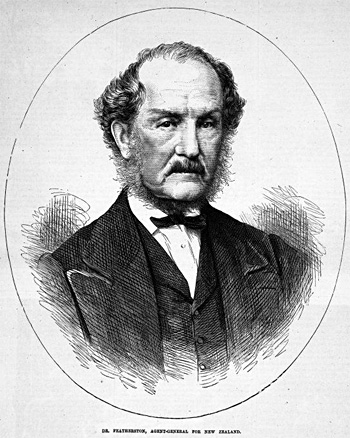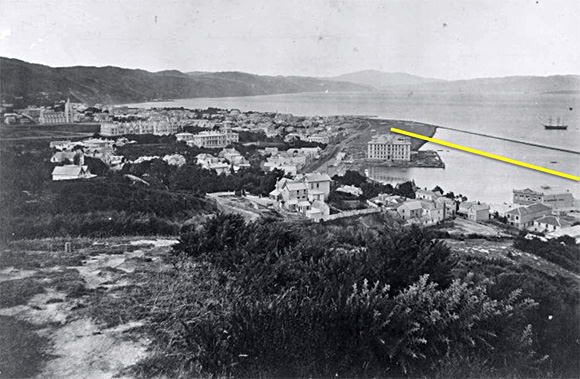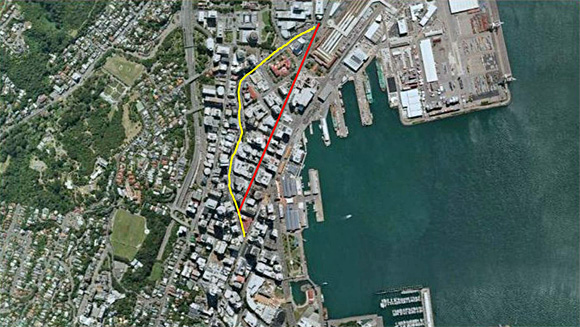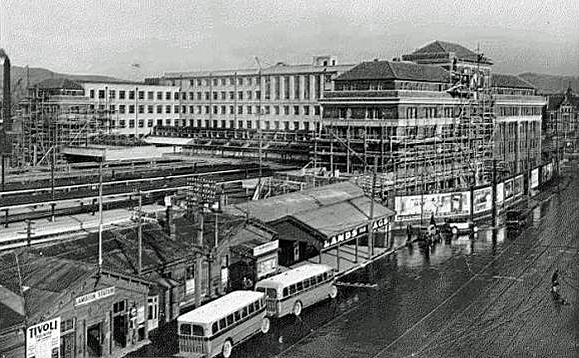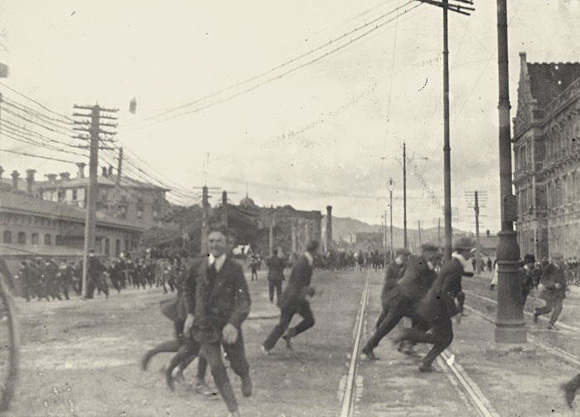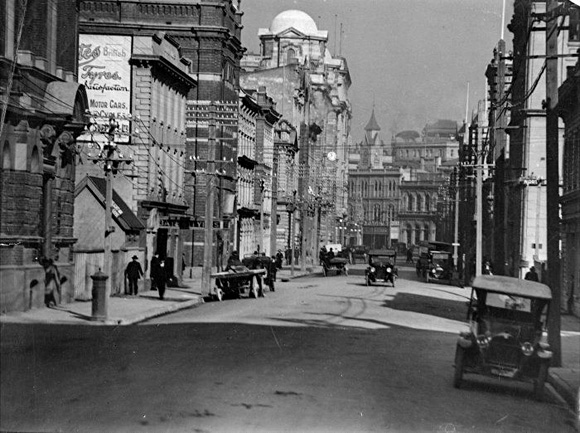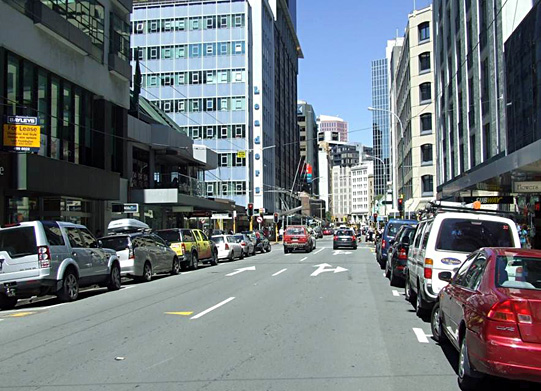|
Zeitblick
/ Das Online-Magazin der HillAc -
21. Juli 2012 - Nr. 43
|
City,
My City |
Series 5, Part 2 A Street Named Featherston
Sailing into the teeth of a northerly gale the 500 ton ship "Olympus" had great difficulty entering Wellington Harbour on April 20th 1841. From London to Wellington, her passengers and crew had endured 132 days on board in a non-stop voyage half way around the world, a distance of over eighteen thousand eight hundred kilometres, only to be prevented from reaching their ultimate destination by a few meagre kilometres. Try as he might Captain Whyte could not bring his ship into the harbour and it took the good will and clever navigational skills of a young local Maori chief, Te Whare (son of paramount chief Te Puni), to finally bring the ship into harbour and safely pilot it to the anchorage in Lambton Harbour, opposite the new and still very small settlement of Wellington. Even after the ship dropped anchor the powerful storm prevented her passengers from disembarking for another three days. So close yet so far, the passengers could do nothing but stare across the storm-tossed waters to the small settlement of Wellington that would soon be their new home, or huddle below decks out of the wet and windy weather. Accompanying the passengers and holding arguably the most important position on board an immigrant ship during those times was Dr Isaac Earl Featherston, Surgeon Superintendent on board the "Olympus". While the ships captain was responsible for his ship, it's navigation during the journey and the conduct and capability of his crew, to the Surgeon Superintendent fell the complete responsibility for all passengers on board. Dr Featherston was accountable for everything to do with the day-to-day life of passengers throughout the journey. Their health and wellbeing, their moral and physical conduct, their provisions and sustenance, their lives, births, deaths and even their religious instruction fell within his job description. The one extra position left to the captain, both then and now, was that of marriage celebrant should his services in this respect be required.
Dr Featherston had decided to travel to southern climes in search of restoration to good health, suffering as he did from the after effects of tuberculosis. Intending initially to travel to Australia, Edward Gibbon Wakefield of the New Zealand Company had persuaded him to travel instead to New Zealand, offering him a berth on one of the original immigrant ships to the new colony of Wellington. We don't know, of course, how his life would have turned out in Australia but the chance decision he made to emigrate to New Zealand allowed him to exercise his medical, philanthropic, literary and political skills to such a degree that in more ways than one he came to stamp an enduring imprint on the fledgling colony. Not only did Dr Featherston impress those on board the "Olympus" with his concern for their physical, social and medical well-being, once on dry land he continued to practice medicine among the immigrants of Wellington, often referred to as "The Little Doctor" which may have been a well-disposed reference to his physical stature. At the various public meetings held in the township (usually at local pubs, which probably had the space for such gatherings) Featherston was an outspoken advocate of the cultural and political life of the colony, often advocating the advantages of self-government for New Zealand. As the first editor for Wellington's leading newspaper the Wellington Independent, Featherston was able to express himself more openly, more vigorously and to a wider audience than ever before. As such he became the voice of the colony speaking out against Governor Fitzroy, Governor Grey and the leading members of the New Zealand Company. Such became the sharpness of Featherston's attacks, particularly on the policies and claims of the Wakefield brothers, that at one time he found himself challenged to a duel by William Wakefield, brother of Edward Gibbon Wakefield of the New Zealand Company, an event which ended in a stalemate when Featherston missed and Wakefield aimed his pistol away from his opponent before pulling the trigger. This confrontational approach brought Featherston to the forefront of local and national politics in his newly adopted home. From his arrival in Wellington at the tender age of 29 to the end of his life in 1876 while overseas working on behalf of New Zealand and the New Zealand government in Britain, Europe and Scandinavia, Featherston was an advocate for the people, politics and independence of Wellington and New Zealand. While his views were often parochial he nevertheless did what he could for New Zealand with an earnestness and enthusiasm that helped him stand out as somone of unique talents and passions. A contemporary once said of him that "He is very persuasive, very resolute, very deep". However enough of the man himself, let us look at the legacy that he has stamped on his much loved city and province of Wellington.
When, in 1841, Isaac Earl Featherston looked out on the fledgling township of Wellington (a far cry from and very obviously not what was promised to him when he was convinced by Wakefield to make the journey) the land on which a thoroughfare named for him did not exist. What was, in the not too distant future, to be dry land was at that time seabed and several meters off-shore from the beach front which was known in those days as Beach Road later to become Lambton Quay. The early fathers of Wellington were sorely pressed for flat land on which to build and expand the township as, apart from the districts of Thorndon and Te Aro, much of Wellington rose steeply from the harbour into the hills surrounding it. Reclamation of land from the sea around Lambton Harbour commenced in the very early days of colonisation and progressed right up until the 1960's. The seabed fronting the beach from lower Willis Street in the south-east through to Thorndon in the north-west was gradually reclaimed between 1857 and 1876, providing land for the development of the city including streets, business premises, housing, hotels and shops. With the required land now available work on planning and laying out the development was progressed such that from mid-1868 work was ready to progress. Following work on this now-available dry from 1867, and the laying out of streets, a report from the "Board of Works" in the Wellington Independent for August 14th 1868 stated thus:- "Gentlemen,- I have the honour to submit the following report of the various works executed since November 1867:- Hunter and Featherston street have been laid off and formed, box drains laid in connection with existing sewers, and the paths kerbed". Featherston Street was clearly one the first of the many streets formed on this new land and a report in the October 1st 1878 copy of the Evening Post suggests that it was the street around which many of the other streets in the area were formed:- "The proposed arrangement as to the street plans of the Thorndon Reclamation is as follows: Along the outer edge of the breastwork and following its course throughout will run a broad esplanade, 120 feet wide, to be called Waterloo Quay" . . . many other street descriptions follow this until we eventually get to Featherston Street as follows . . . "Featherston Street runs right through the whole length of the reclamation to Thorndon Quay, joining the latter near the present railway station."
The reference to "the present railway station" above alludes to an interesting fact about Featherston Street. In one way or another the street has been closely associated with every Wellington railway station that has existed....and there have been a few over the years. Between 1874 and 1884 the original railway station, known as Pipitea Point Station and serving as the terminus for the Wellington to Wairarapa railway, was situated not far north of where the red and yellow lines join at the top of the picture. In 1878 the nearby disused Railway Hotel caught fire which, fanned by very strong north-west winds, quickly spread to the nearby Pipitea Point Station building and to several other buildings in the vicinity. Although valiant efforts to extinguish the flames were made by several engines of local fire brigades, the Evening Post of January 17th 1878 stated that "...at four o'clock the hotel, the railway station, booking-office, waiting-room's, engineer's office, manager's office, the house above alluded to, and an outbuilding of the hotel, all combined to form one mighty blaze." The destroyed railway building was quickly replaced by a temporary structure which was eventually closed in 1884 when the new railway line was constructed on recently reclaimed land. This extended the railway line southward and a station was built near the corner of present day Whitmore Street and Featherston Street. Road extensions meant that this station was closed in 1885 and the railway station building was pulled on rollers by a large number of men northwards along the east side of Featherston Street to it's new location at the junction of Featherston Street, Mulgrave Street and Lambton Quay where the red and yellow lines converge at the top of the picture above. This was now known as the new Government Station. In the late 1930's nearby reclaimed land to the east of Featherston Street was used to build the current Wellington Railway Station which was opened on June 19th 1937 and recently celebrated its 75th year of existence and continuous operation. Even today the commanding and elegant edifice sits on the eastern side of Featherston Street north.
Featherston Street often misses out on the parades, celebrations and protest marches which more often are routed from Civic Square down Willis Street and Lambton Quay to Parliament or from Parliament up Lambton Quay and Willis Street to Civic Square. The route and time of day (usually 12 o'clock) is designed to strike the most Wellingtonians out on the streets or in nearby offices. Not that we are averse to parades, we Wellingtonians love 'em, but the direction often depends on the purpose of the march. If it is a protest against Government policy or a celebratory event into which our politicians feel they should have some input (without of course having to move too far from their offices) it is towards Parliament. If it is an event to launch a campaign (say the Rugby Sevens World Series) or to celebrate success (say capping parades for Victoria and Massey universities) the march is invariably headed towards Civic Square. One event which did occur, in the main, in Featherston Street took place on November 5th 1913 and became known in Wellington folklore as "The Battle of Featherston Street". October 22nd, 1913 saw the commencement of a strike by Wellington watersiders (wharf labourers) over the refusal of a shipping company to pay shipwrights (skilled shipping artisans) travelling time in association with their job. The strike, along with a parallel strike by miners at the Huntly coal mine, spread throughout New Zealand to became the first nation-wide strike in New Zealands history. Concern over the strike amongst New Zealand commercial interests was associated with its impact on exports and the associated income for both the country and said commercial interests. Amongst the means used in an attempt to break the strike (control striking workers and force them back to work) the Government of the day, the Reform Government of William Massey, utilised "scab labour" (replacements for striking workers not sanctioned by unions) and "special constables", otherwise known as "Massey's Cossacks" or recruited farmers on horseback whose role was to keep order amongst the strikers, being backed as they were by local police and armed forces. On November 5th the strikers in Wellington tried to prevent a shipment of racehorces from leaving Wellington to be shipped south to compete in the New Zealand Cup meeting at Christchurch. It was after 3 pm on that day when a very large contingent of "cossacks" rode towards the Railway Wharf "...to ensure the safe shipping of some thirty valuable thoroughbreds to Lyttelton...". The strikers tried to drive them off with "...volleys of missiles of the sort usually resorted to, accompanied by much abuse..." and the situation became very heated resulting in a horeseback charge undertaken by "Massey's Cossacks" into Featherston Street and towards the massed strikers. The men scattered in all directions down the street and into neaby cross streets to shelter in buildings and alleyways and newspapers of the following day (with obvious bias towards the establishment) were filled with stories of the violence evinced by both sides and of events as they were recorded by witnesses and newspaper reporters there on the day. Of the "cossacks" it was written that they "...stood insult upon insult, and several attempts to unhorse them, without retaliation, and took no notice of stone-throwing. It was not until the fusillade became so 'hot' that the brave and 'war-scarred' rearguard brought their batons into play." The events of the late summer afternoon ebbed and flowed through neaby streets with many a gash and sore head while the occasional injured or unconscious "special" or striker was carried to safety. Some local residents also narrowly escaped being implicated in events and "...several persons who were injured during the disturbance along Featherston Street received first aid from Mrs H W Preston and Miss Redward, of the Ambulance Brigade, who, with other members of that organisation, were on duty in various parts of the city." Over ensuing days the strike continued, although not in such spectacular form as it had on November 5th, however as the struggle dragged on, economic hardship and government pressure wore the strikers down. A general strike was called for 10th of November, but it was not supported and on the following day several of the strike leaders were arrested effectively winding up any resistance from the watersiders. The "The Battle of Featherston Street" and its aftermath was over.
The straight arrow of Featherston Street driven as it is into the heart of it's namesakes beloved Wellington, a thoroughfare for vehicles and pedestrians bound into the city, remains almost exactly today as it was when first laid off in 1867. Of course the buildings situated on either side of the street have changed and while this still includes several office blocks, the mix is more towards public entertainment and acccomodation, shopping and commerce. Featherston Street is one of Wellington's best known dining and entertainment areas, being the home of a significant number of restaurants and pubs of a wide and diverse variety. In addition there are some shops, several hotels and the head offices of two of New Zealand banks along it's 882 meter length as well as Wellington Railway Station, Inland Revenue National Office and a campus of both Massey and Victoria universities, while at it's northern end is the oldest still operational pub in New Zealand, The Thistle Inn. Dr Featherston's Street remains, as does the rural town in the Wairarapa also named Featherston for him, a testament to his involvement and building not only of this nation but also of Wellington and its environs, an involvement he continued until his dying day. In 1872 Featherston left New Zealand for London where he took up the post of Agent-General for the Colony to speak on behalf of the New Zealand Government in the "home country" and to gain willing participants in the drive to increase immigration to New Zealand. His health continued to deteriorate until he finally passed away on June 19th 1876 at Hove in Sussex, England. The Appendix to the Journals of the House of Representatives for the government of New Zealand speaks of his death as follows: "New Zealand has lost, by the death of Dr Featherston, a distinguished colonist, and an upright and conscientious public servant, whose first thoughts were always how he could best serve the interests of his country."
© Peter Wells, Wellington, New Zealand |
